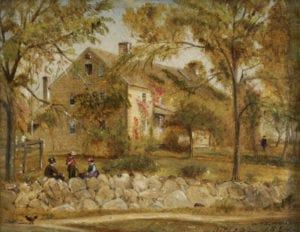The 12th Annual Vintage European Sports Car & Motorcycle Display was held on the front lawn of the Stony Brook Community Church on Saturday, Aug. 13. In spite of record high temperatures, the free event attracted a nice crowd who admired over 30 European cars and motorcycles and enjoyed live music by The Barking Men and refreshments. The oldest car on display was the 1926 Bentley 3-litre, with 18 documented owners during its lifetime, including several in New Zealand. The 1947 Morris-Garages MG-TC won the People’s Choice award for Best Car in Show. All proceeds went to the outreach mission of the church, especially the scholarship program of its annual Children’s Performing Arts Camp.
Sights from Port Jeff’s 2016 Greek Festival








Port Jefferson’s 2016 Greek Festival kicked off Aug. 18 and has three remaining dates from Aug. 26 to Aug. 28. The annual cultural celebration is hosted by the Greek Orthodox Church of the Assumption at Port Jefferson and features food, activities, music, fireworks and more.
North Shore, Suffolk County, receive historical grants

By Desirée Keegan
Thousands of dollars have made their way to North Shore historical nonprofits, which will help continue to preserve Long Island’s rich history and educate others on it.
The Robert David Lion Gardiner Foundation funds Long Island’s history-based 501(c)(3)s, museums and universities to help with object conservation, historical preservation, education programs and exhibits. The organization was established in memory of Gardiner’s Island, a part of East Hampton town.
“The foundation grants have become highly completive,” Executive Director Kathryn Curran said. “For this round, the board reviewed 43 applicants that covered every form of historic outreach. Projects included restorations, exhibitions, programs and collection digitization.”
Most recently, local historical societies, Friends of Science East Inc., Suffolk County Historical Society, The Nature Conservancy, 3rd NY Regiment Long Island Companies and Stony Brook Foundation, among others, were the 2016 first round recipients.

Joseph Attonito, chairman of the board of directors, said there were many great groups to choose from.
“It is very gratifying to have so many worthwhile organizations overseeing our local heritage and preserving our history,” he said. “Bob Gardiner would be very pleased.”
Rocky Point Historical Society received $7,500 for restoration use and, according to historical society President Natalie Aurucci Stiefel, the funds are being used for repairs and restoration of The Noah Hallock House, built in 1721.
“We feel very privileged to have the foundation choose us for that grant,” she said. “It is important to keep this historic house in good shape. We would’ve had a hard time fundraising that money.”
According to Stiefel, the house, which holds tours on Saturdays between 1 and 3 p.m., was the birthplace of revolutionary soldiers, and had the possibility of being torn down several years ago before Mark Baisch, owner of Landmark Properties in Rocky Point, stepped in to help.
“We still have staircases that the servants and slaves used,” Stiefel said. “It’s filled with artifacts and photographs from the 18th and 19th century, and there’s even a 20th century room dedicated to the radio history of Rocky Point.”
The Port Jefferson Harbor Educational and Arts Conservancy received $16,354.09 for it’s annual Heritage Weekend festivities.

According to Nicole Christian, a consultant for grant writing for Port Jefferson Village, about 50 percent of the funding from the weekend came from the grant.
“The larger, more impactful exhibits and reenactments that would have lasting public benefit, that’s what they supported,” she said.
“We made sure that we tailored a lot of the activities that you see with the cars and the beach scene — we made sure that it all weaves together to celebrate the history of Long Island, particularly the 18th century.”
All 19 locations around the village that hosted the event covered a particular time period in Long Island’s history. According to Christian, the funding helped Port Jefferson be able to create a larger and grander event than would have originally been possible.
“We had all levels of recreational activities here,” she said. “We’re hoping that [visitors took] away a greater appreciation for Long Island’s role in 18th century history, the colonial period, the Revolutionary War, a recreational pastime. People don’t know that [Port Jefferson was] a magnet of recreation for all families.”
The Historical Society of Greater Port Jefferson also received grant money, totaling $22,000 for restoration purposes.
The 3rd NY Regiment Long Island Companies was awarded $12,000 to substitute payment customarily made by collaborators, host sites and venues during the campaign season, allowing those organization to apply those resources to other priorities associated with their missions. The Regiment partakes in re-enactments to educate Long Islanders on the Revolutionary War.
“They are quite an extraordinary group of volunteers who perform a vital role in helping our county’s residents and visitors get a very personal education about colonial life and the role Long Island played in the Revolutionary War,” Richard Barons, the executive director of the East Hampton Historical Society, said.

The Smithtown 350 Foundation received a $5,000 grant toward anniversary events, as the town celebrated its 350th anniversary this year. The Walter S. Commerdinger Jr. County Park Preservation Society in Nesconset received $100,000 for restoration and preservation purposes.
The Huntington Historical Society received a $12,728 grant that Executive Director Claudia Fortunato-Napolitano said will be used to purchase new technology products and technical support.
“With the new technology and updated software that [the] funding will provide for, the society can continue to stay relevant in the 21st century,” Fortunato-Napolitano said in an email. “We will be able to stay better connected with our members and donors, while increasing the number of people who we can help with their research… [It] will lead directly to the growth of the organization as the goal is for the society to successfully engage more members of the public and the community. For small not-for-profits like ours with a limited budget, vital technology updates is often an item that can seem too costly to afford.”
The Old First Presbyterian Church in Huntington received $50,000 for restoration and conservation of the steeple.
The Ward Melville Heritage Organization was awarded $22,500 for an educational program called Distance Learning.
According to Gloria Rocchio, president of the organization, an instructor will give a lesson, in say, the Bewster House, and it would be filmed and broadcasted onto the Distance Learning website.

“People from around the world could learn about the rich history we have here,” she said. “We already have the cameras installed in the Thompson House and the Brewster House, and we’re developing programs for them. Once program should be ready this fall, and the other should be ready next spring. It’s very exciting.”
Friends of Science East Inc., more commonly known as Tesla Science Center at Wardenclyffe in Shoreham, received $17,500 for capacity-building technology and $3,800 for collections care.
According to board of directors President Jane Alcorn, the funding will be used to survey the property, especially the lab building and power base, to study its historic nature — identify which parts are historic, have architectural drawings done, and figure out which parts are critical to preserve and protect, and how to do it.
“The funding will help as we continue to protect the site as we work toward getting it on the National Register of Historic Places,” Alcorn said. “We know the history of the project is historic. It has significance because of Tesla’s work there — it’s a scientific site. Its architectural origins, in inspiration of Stanford White, an important architect at his time, [are also significant].”
Alcorn said that every dollar is significant, as the nonprofit looks toward the future of turning part of the site into a museum — and the funding makes the creation of a museum more exciting, if the organization can get the property on the national list.
“We believe in preserving and making the best possible choice in how we use that space,” she said. “Having the grant enables us to develop ideas that bring together the past and the future. We have far more fundraising to do moving forward, so the contribution really helps us realize and achieve the steps necessary to move forward. The Robert David Lion Gardiner Foundation has been magnificent, and we applaud their foresight into giving to organizations such as ours, who want to preserve the best of the past.”
Victoria Espinoza and Alex Petroski contributed reporting.
New trail will benefit, unite and celebrate Suffolk

Every project has its perks, and in the case of one large North Shore endeavor, the possibilities are endless.
U.S. Rep. Lee Zeldin (R-Shirley), along with other local officials, recently announced a 2018 completion year for the Port Jefferson Station to Wading River Rails to Trails project — that has been more than 30 years in the making. With the plan, which involves paving a bike path where old railways existed to be used for cyclists, potential is everywhere.
While the project will provide a safe space for biking enthusiasts, skateboarders, roller-bladers and even those just looking to take a scenic stroll, there is also a huge chance for economic growth, with the path connecting so many Town of Brookhaven hamlets. Bikers, hikers and anyone in-between could stop at kiosks along the path to grab a bottle of water or an ice cream cone, or groups may stop in any hamlet along their travels to grab dinner or go shopping. The trail could also be a way to connect locals, and tourists too, to local beaches, museums and other landmarks.
It’s also just a great opportunity to explore the wonders of the North Shore. The plan helps preserve even more open space while stringing together breathtaking views that tend to get lost in all of the development on Long Island.
Further, the trails should serve as inspiration for cars to be left at home occasionally, which can only have a positive impact on the environment around us.
This project is attractive on multiple levels and across multiple layers of government. We applaud officials for being able to work together and across party lines to achieve a common goal with so many benefits.
SBU drones set for lifesaving liftoff in Madagascar
By Daniel Dunaief
Stony Brook University is taking to the skies to help people on the ground in Madagascar. Through its Global Health Institute, SBU plans to bring drones to the island nation off the southwest coast of Africa that will carry medical samples from hard-to-reach villages to its state-of-the-art research facility, Centre ValBio.
Late last month, Peter Small, the founding director at GHI, brought a drone to Madagascar, where it flew from the research station to a nearby village. The drones can fly like an airplane over 40 miles of terrain, while they take off and land like a helicopter, enabling a smooth ride to protect the samples inside the cargo area.
“Our challenge is to align the most pressing challenges that are amenable to supply chain and specimen transport and intervention,” Small said. Madagascar is dealing with “high rates of tuberculosis” among other health challenges, he said, adding that a university like Stony Brook can take complicated problems and find solutions in the real world.
The drones can provide two important functions for Madagascar: monitoring the outbreak of any unknown and potentially dangerous disease and offering health care for people who live in areas that are inaccessible by road, Small said.

“Diseases like Ebola and Zika frequently pop up in remote areas,” said Small, a medical doctor who worked at the Bill & Melinda Gates Foundation prior to joining Stony Brook University in 2015. Having sites where drones can land and collect specimens will allow village health workers to send off specimens for analysis, providing greater clarity on the incidence of specific diseases throughout the country.
Additionally, people in remote areas can send samples back to a lab to test for medical conditions, such as tuberculosis. After medical technicians run tests, the drones can return not only with drugs that can treat the condition but also with instructions on how to treat patients.
The drones can carry a special box to record whether a pill bottle is opened. The box also can carry a sound recorder that can recognize and count coughs, Small said. When the drone returns with another supply of medication, the previous medicine can make the return trip to the lab, where doctors can determine whether the cough is getting better and can see how much medicine the patient took.

Ideally, the drones will not require any specialized knowledge to fly. Once people in rural villages have a signal, they can request a drone, which can transport samples to a lab or bring medicine back to the village.
“We want to put these drones in the hands of the village health workers and the local health system,” said Small. He said those working with this project hoped people in the village would welcome this medical service but were unsure how it would be received. “We had no idea how people would respond to these” drones, Small said. The initial run, however, was successful. GHI plans to bring two more drones to Madagascar in the next few months.
A company in Michigan called Vayu manufactures the drones, which weigh 35 pounds, are about the size of a picnic table and can carry up to a 5-pound payload, said Daniel Pepper, the company’s chief executive officer. Using an electric, rechargeable battery, the drones can travel up to 40 miles. In the near future, Pepper hopes to increase that distance to as many as 65 miles.
Vayu has manufactured dozens of these drones. The recent Madagascar test was the first time they had used the unit in an international setting. Pepper is “speaking to partners and potential customers in over a dozen countries,” including the United States, where drones might offer a connection between medical centers in urban areas and harder-to-reach rural communities.
Pepper said the drone was the only one on the market that’s electric powered and can carry this payload over this range. “It takes off automatically and lands vertically,” he said and described the landing as “soft.”
According to Small, Madagascar could benefit from these drones, particularly in diagnosing the myriad health challenges of the area. “Madagascar is a remarkable area to start addressing some of these problems and bringing innovation,” he said.
In some villages, as many as 90 percent of people have intestinal parasites, which contributes to malnutrition and stunts growth, Small said. Small and Patricia Wright, the founder and executive director of Centre ValBio who has been working in the area for 30 years, are hoping to broaden and deepen the connection between Stony Brook and Madagascar.
The dental school has coordinated dental missions to treat hundreds of patients a day. Small said the dean of the dental school, Mary Truhlar, recently visited Madagascar to go beyond medical missions to “engage in improving the quality and training, care and health system issues.”
Small is excited with the way computational science and high-end mathematics are coming in to describe the complexities of health problems to the government of Madagascar. This will assist the government in generating medical priorities. Small has set some large goals for his role: “If life is not palpably better in five, 10 or 15 years” in Madagascar, “I will have failed at my job.”
New Mount exhibit opens at the LIM

By Ellen Barcel
The Long Island Museum in Stony Brook revealed its newest exhibit, Drawn from Life: Objects and Stories from William Sidney Mount’s Paintings Aug. 12. Mount was an early 19th-century genre artist who lived from 1807 to 1868. Born in Setauket, Mount spent much of his career in Stony Brook. He is buried in the Setauket Presbyterian Church’s Cemetery.

Julie Diamond, director of communications at the museum, noted that the William Sidney Mount house, located on the corner of Route 25A and Stony Brook Road in Stony Brook, is preserved to this day. Mount had his studio in the third-floor attic of the house, which was built in 1725 and became a National Historic Landmark in 1965.
The Long Island Museum has the largest collection of Mount’s work and memorabilia in the world. His paintings show ordinary people doing ordinary things: washing laundry, dancing to the music of a violin, fishing, trapping, etc. He was a contemporary of the Hudson River School of painting.
The exhibit is curated by museum assistant curator Jonathan Olly. New to the LIM since February, he earned a doctorate in American studies just a few years ago from Brown University. Although this is his first major exhibit at the LIM, he knew he wanted to become a museum curator back when he was a summer intern in Washington, D.C., at the National Museum of American History. “I’ve been working in museums since 2001,” he said.
One of the really unique paintings on view is the portrait of Robert Morris Russell. According to Olly, Mount painted it in 1832 along with a portrait of Russell’s wife and mother. The painting has not been on display “in over 40 years.” It needed conservation, which was provided through a Greater Hudson Heritage grant.
Russell “died that year, a victim of the cholera epidemic in New York.” Olly continued, “He was a merchant in New York [City]. His wife, Ruth Amelia Smith Russell moved the family back to Long Island after he died.” Since both his and his wife’s portraits are on display, this “is the first time they are reunited in public since the 1970s.”
Olly noted that in assembling the exhibit “we also drew on our textile collection to outfit mannequins.” An 1830s black dress and a man’s black waistcoat are paired with these two portraits.
While some of the objects paired with each particular painting are of the period, a few are actually the items Mount painted. One of Mount’s original easels is on display, along with one of his violins. The 1857 instrument, one of the Cradle of Harmony violins he designed, was unique in that it had a concave, instead of a usual convex, back in order to “create a larger sound in a crowded room,” at a time when there was no electricity — no amplifiers. “He used and played the violin himself, but there was never any interest in manufacturing it,” said Olly. The violin is paired with “Catching the Tune,” showing a fiddler holding that actual instrument.
In the portrait of Mount’s sister Ruth, she is shown with her child, Charles. The original dress that the baby is wearing in the painting is on display as well.

Six paintings are paired with current photos of the same locations. Most of these were taken by Olly, including that of Patriot’s Rock in Setauket. The photo of the barn, shown above, was taken several years ago by Diamond. “The doorway of the barn frames the image that Julie took of three kids, in programs,” held at the museum. The barn is the Williamson barn, believed to be the one Mount painted in “Dancing on the Barn Floor,” below, which was moved to the LIM property for preservation. Olly added, “it’s amazing that these places still do survive,” after more than 150 years.

Seniors age 62 and over are invited to visit the museum (free admission) on a normally closed day, Sept. 13, to take a self-guided tour of the exhibit from 10 a.m. to noon as part of the museum’s Senior Tuesday program.
The new Mount exhibit will be used in the museum’s children’s programs as well, including Meet the Museum: A World Without Cars (with a focus on carriages), Meet the Museum: Through an Artist’s Eyes (with a focus on art) and The New Nation: The World of William Sidney Mount (focusing on business and transportation). Detailed teacher’s information is available for download on the museum’s website.
The Long Island Museum, 1200 Route 25A, Stony Brook will present Drawn from Life: Objects and Stories from William Sidney Mount’s Paintings through Dec. 31 in the Art Museum on the hill. The museum, a Smithsonian affiliate, is open Thursdays through Saturdays from 10 a.m. to 5 p.m. and Sundays from noon to 5 p.m. For further information, call 631-751-0066 or visit www.longislandmuseum.org.
Photo of the Week
Karen Silvestri of Melville, an avid nature photographer, captured this image of a colorful dragonfly on a recent visit to Avalon Park in Stony Brook.
Send your Photo of the Week to [email protected].
Blood drive in Brookhaven
Brookhaven Town will hold a blood drive Tuesday, Aug. 23, from 8:30 a.m. to 4 p.m. in the Town Hall auditorium in the hopes of alleviating an emergency blood shortage. Brookhaven Town Hall is located at 1 Independence Hill in Farmingville. Those seeking more information are advised to call 631-451-9100.
Local runners compete in marathon to support vets

By Desirée Keegan
Four North Shore runners have joined Team Mission United, competing for the charity United Way of Long Island during the 2016 TCS New York City Marathon.
Steve Kostoff, Erick Rosales, Kathy Wagner and Deena Menendez will team up with five other athletes for the 26.2-mile race, which will take place on Nov. 6 and benefit 135,000 veterans and military families on Long Island.
Kostoff, who lives in Mount Sinai, said as soon as he found out Mission United was the program he would be running for, he went to the organization’s website to learn about its works, which focus on employment services, education, financial services, health and housing support.
“Many of these men and women went overseas to fight for us, now they have to come back and in many cases fight for themselves to receive care,” he said. “Any way I can help to raise funds or get the word out is important.”
“It’s a great opportunity to give back and do my part for veterans — they have sacrificed so much to give us our freedom.”
— Erick Rosales
Kostoff works for Suffolk Bus Corp. as an ADA bus driver. Through his job he’s supported United Way of Long Island over the years, and has come to hear many stories of veterans and their special needs, as he often transports disabled veterans to Northport VA Medical Center for appointments.
John Corrado, president of Suffolk Transportation Service and past president of United Way of Long Island’s board of directors, is pleased to support Kostoff in his efforts as he runs his first full marathon.
“To have the chance to see an exemplary employee like Steve compete is truly inspiring,” he said. “Not only will be have our organization’s support, but I am certain that his colleagues will rally around him on his journey to the finish line.”
Rosales, of Coram, a UPS driver, is also eager to compete. He said he’s been training for the marathon for a long time and has previously competed in 10 others, including the NYC Marathon which he’s raced in three times.
“It’s a great opportunity to give back and do my part for veterans — they have sacrificed so much to give us our freedom,” he said. “We should honor all veterans whenever we have the chance. Compared to what they have done for us the effort by me is just a drop in the bucket. I’m in 100 percent.”
Rosales will be joined in the race by his good friend, fellow colleague and training partner, Bill Ude.
Wagner, of Huntington, is meeting the challenge with great enthusiasm.
“It was a no-brainer for me,” she said of choosing to be a part of the race. “I never thought I’d run in the NYC Marathon because it’s really difficult to get in to, but when the opportunity presented itself I couldn’t say no.”
Wagner, generalist manager for the Long Island Region of Enterprise Holdings, is the leader of the Enterprise United Way of Long Island campaign which she’s been running since 2008, so she’s a big cheerleader and supporter for the cause. She said she feels Mission United is a vital program to assist veterans.
“Training is a part-time job and it’s nothing compared to what these men and women have done for our country. This will help with the needs of our veterans returning home.”
—Deena Menendez
“This is a huge race supporting a huge cause … I’m really excited for it,” she said, adding that she has a lot of family members who are veterans, including her grandfather, three uncles and a couple of cousins whom she’s close with. “I know the struggles they’ve had returning after they’ve served, and I think that any organization that’s there to help that process and help them acclimate back into society is totally worthwhile and totally worth raising money for.”
Wagner has competed in both 5K and 10K events, half marathons, mud runs and warrior dashes. Her boss, Eric Schonhoff, Enterprise’s regional vice president who has also been supportive of United Way of Long Island and serves on the board of directors, is inspired by Wagner’s efforts.
“Not only is it great to back a seasoned runner like Kathy, but she also deserves accolades for putting her heart and soul behind Mission United and the entire campaign,” he said.
Menendez, of Hauppauge, who is a claims adjuster for Geico in Woodbury, is running for Team Mission United as a labor for love, as she too is surrounded by family members in the military. Her husband is an Air Force veteran; her eldest son Sean is in the Coast Guard serving in Astoria, Oregon; her middle son Scott served in the Army; and her youngest son, Shane, is a Marine in San Diego, California.
She began intense training for the marathon and was approached by a past supervisor about volunteering to become a participant for the team, and was delighted to accept.
“It’s an honor for me just to be in the run,” Menendez said. “I keep my family in my thoughts to motivate me. Training is a part-time job and it’s nothing compared to what these men and women have done for our country. This will help with the needs of our veterans returning home. They face so many challenges acclimating to civilian life after military life, so Team Mission United helps them get homes and jobs, and raising money will help benefit so many more veterans.”
Participants have set a goal of raising $20,000 for United Way of Long Island’s veterans programs, and are looking for support. To learn more about the team and its efforts, visit www.unitedwayli.org/team-mission-united-supports-long-island-veterans.
John Tsunis takes Gold Coast Bank public fast

By Wenhao Ma
In little more than eight years, John Tsunis’ Gold Coast Bank has gone from one location in Islandia to a publicly-traded company with six branches on Long Island, and another opening in downtown Brooklyn.
Now he’s contemplating the bank’s first branch in Manhattan, because many of the customers and stockholders on Long Island are also residents of New York City.
“I don’t want to build a wall between us and New York City,” Tsunis said.
Tsunis, 65, has multiple business interests. He is not only the chairman and chief executive officer of Gold Coast Bank, but is also on the board of directors of the New York State Hospitality & Tourism Association, and the founder and CEO of Islandia-based Long Island Hotels. He opened the first Holiday Inn Express franchise on Long Island in Stony Brook in 1991, which was the first in the United States.
According to Gold Coast Bank’s 2016 second quarter report, its net income reached $573,000, a 178 percent increase compared to the same quarter last year. Its assets, deposits and loans have all increased compared to 2015.
The bank also reported year-to-date net income of $991,000.
Gold Coast Bank went public in June, issuing about $9.5 million in shares.
“We are encouraged by our original investors who continue to support our community bank, as well as new investors who have come aboard,” Tsunis said in a statement.

After his first bank, Long Island Commercial Bank, was taken over by New York Community Bancorp in 2005, many clients felt the new, larger bank no longer offered a personal touch. So Tsunis created Gold Coast Bank.
“We used the same model [as we did for Long Island Commercial Bank], almost like a private bank, where we could meet with our neighbors and help them,” Tsunis said. “The bank has a tremendous opportunity to help the development of the growth and the success of the neighbors in our community.”
He said Gold Coast Bank reinvests clients’ deposits right into the community where they are located.
“You deposit money here and we don’t send it to Europe, China or South America like a multinational bank,” he said.
Tsunis remembers when he and his bank helped a Stony Brook restaurant that had trouble funding an expansion.
“That’s not a big enough fish for them,” he said, explaining why the big banks wouldn’t lend money to the restaurant. “For small banks like ours that are in our community, every fish is a big fish.”
Tsunis said he was familiar with the owners, who had been in business for a long time.
“We took that as an opportunity to support the community and a local merchant,” he said, adding that he responded right away.
Tsunis said his father worked in a restaurant in Manhattan. When the son was 12 or 13 years old, he used to go to work with his father every Saturday. His job was to bring coffee and egg sandwiches to the customers, which helped him develop a good work ethic.
Growing up, Tsunis always wanted to be a lawyer and get into the real estate business. He graduated from New York University with honors in banking and finance in 1973, and earned his doctor of law degree from Syracuse University College of Law two years later. Before long he started his own law firm with a personnel comprising himself and a secretary.
“By being a lawyer, I thought I would understand the language of the real estate world and legal world,” he said. “I have tremendous passion for whatever I did. I didn’t want to do anything just for the sake of doing it. I enjoy law, I enjoy practicing land use and I enjoy developing real estate.”
A blueprint for a happy life is what Tsunis would most like to pass on to the next generation.
“Whatever it is that you want to do,” he said, “make sure that you have a smile on your face and the passion for what you want to do because you are going to spend an awful amount of time at work.”
Tsunis is establishing a scholarship at the College of Business at Stony Brook University to help young people who want to enter the business world. He is personally donating $25,000, and the bank will add to that.
Andrew Polan, president of the Three Village Chamber of Commerce, said that Tsunis, who is a very active board member in the chamber, likes to get the community involved, recalling that two years ago Tsunis spent $1,000 on tickets to a barbecue at West Meadow Beach, and gave them out free to guests at the Holiday Inn Express.
“Currently, he wants to get all parts of our community, including the faculty, staff and maybe students of our great Stony Brook and Three Village community together to do a huge New Year’s celebration — maybe centered at the new sports arena on campus,” Polan said.
Cris Damianos, vice chairman of the bank, said that Tsunis is a charitable person and a big donor to charitable organizations, adding that he understands doing business is not a one-way street.
To help the community, Damianos said that the bank lends money not only to businesses, but to religious institutions as well.
Tsunis said he believes that his and the bank’s efforts to help the community will pay off.
“I think if we germinate those seeds, those young students, the residents of the New York metropolitan area and international students as well, will help this economy, this county, this state and country to be a better place to live,” he said.





















